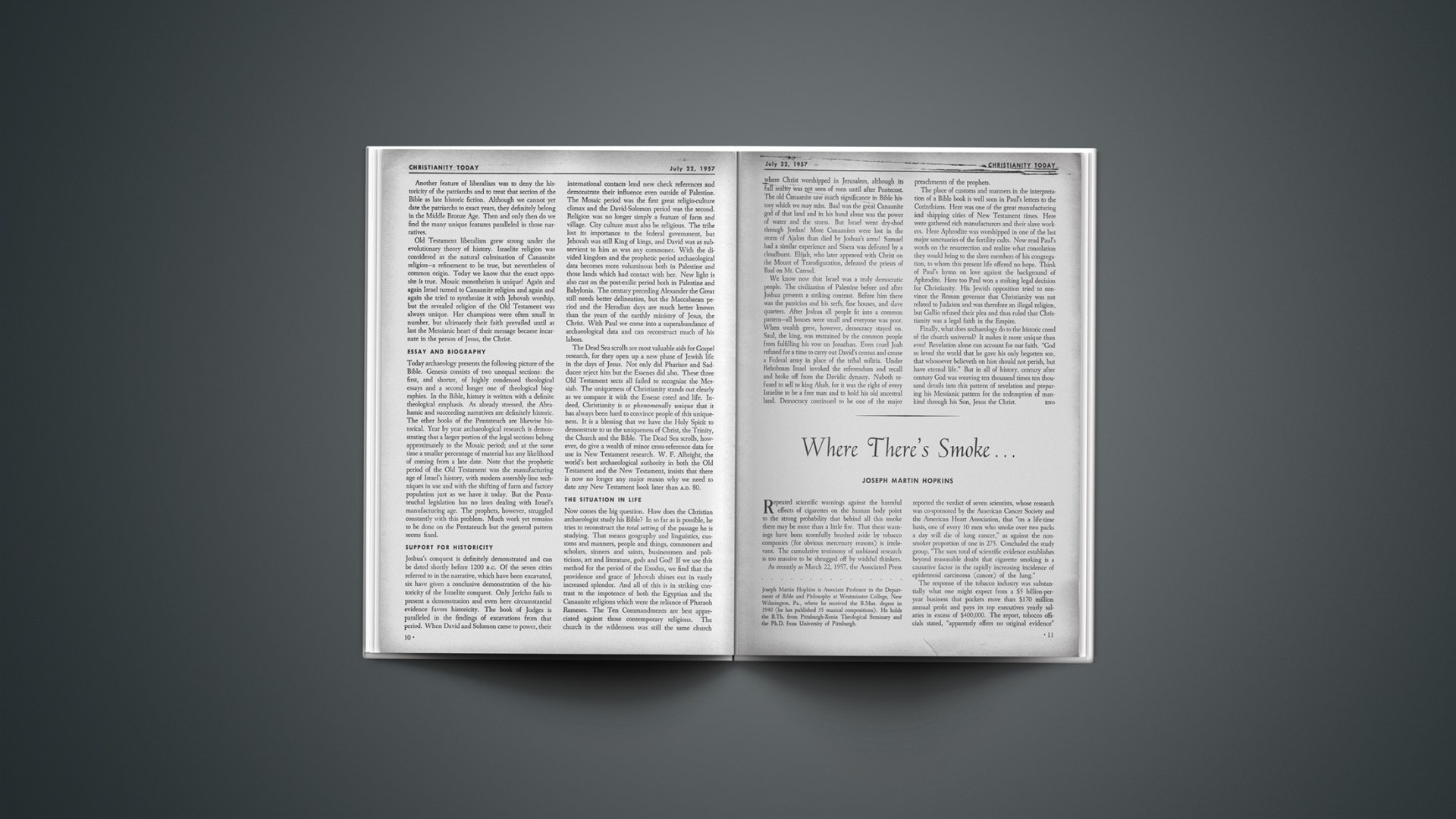Repeated scientific warnings against the harmful effects of cigarettes on the human body point to the strong probability that behind all this smoke there may be more than a little fire. That these warnings have been scornfully brushed aside by tobacco companies (for obvious mercenary reasons) is irrelevant. The cumulative testimony of unbiased research is too massive to be shrugged off by wishful thinkers.
As recently as March 22, 1957, the Associated Press reported the verdict of seven scientists, whose research was co-sponsored by the American Cancer Society and the American Heart Association, that “on a life-time basis, one of every 10 men who smoke over two packs a day will die of lung cancer,” as against the nonsmoker proportion of one in 275. Concluded the study group, “The sum total of scientific evidence establishes beyond reasonable doubt that cigarette smoking is a causative factor in the rapidly increasing incidence of epidermoid carcinoma (cancer) of the lung.”
The response of the tobacco industry was substantially what one might expect from a $5 billion-per-year business that pockets more than $170 million annual profit and pays its top executives yearly salaries in excess of $400,000. The report, tobocco officials stated, “apparently offers no original evidence” and relies heavily on statistics that have been “widely questioned by other scientists as to their significance.” Gabriel Courier has commented in Christian Herald, “The tobacco industry says it’s doubtful that cigarettes cause lung cancer. The classic and unnerving answer to that one is the Roy Norr gem—‘Who should have the benefit of the doubt—people, or cigarettes?’ ”
In first-century Ephesus, Demetrius and his fellow silversmiths stirred up a city-wide tumult over the inroads of Christianity upon their idol-making profits. With similar irresponsibility and avarice, the tobacco industry is diverting $33 million annually into an all-out advertising effort to combat the devastating findings of impartial medical research. But this vigorous propaganda campaign notwithstanding, an estimated 1.5 million smokers swore off cigarettes during an 18-month period beginning in the fall of 1953, according to the U. S. Census Bureau. This figure compares with that of 600,000 for the previous year.
Tobacco advertisers, eager to enlist new smoking recruits, would like the public to believe that “everybody does it.” But the U. S. Census Bureau reports a national total of only 38 million regular cigarette smokers—25 million men and 13 million women. The addition of 10 million pipe and cigar users and 8 million occasional smokers brings the grand total to 56 million—which means that there are well over 110 million nonsmokers in the nation.
Dr. Charles S. Cameron, Medical and Scientific Director of the American Cancer Society, has reported that during the period 1930–1948 “the death rate from lung cancer rose from 5.3 per 100,000 to 27.1—an increase of 411 per cent.” The ratio of men to women dying from lung cancer also has soared and is currently 8 to 1. Significantly, this alarming trend has been accompanied by a parallel upsurge in cigarette use. In 1914 the United States produced 3 billion cigarettes; in 1918, 46 billion; 1935, 140 billion; 1945, 332 billion; 1952, 395 billion.
Dr. Cameron, in an Atlantic Monthly article entitled “Lung Cancer and Smoking,” cited the Lombard-Doering investigation of 1928 as the first “properly controlled statistical (study) of a possible relationship between cigarette smoking and lung cancer.” Ten years later Professor Raymond Pearl of Johns Hopkins University, upon analyzing case histories of 6,813 men, concluded that a heavy smoker at age 30 has 46 chances out of 100 to attain the age of 60, while the nonsmoker has 66 chances. In 1950 four independent statistical studies revealed a high correlation between cigarette smoking and lung cancer, and during the next five years this conclusion was corroborated by more than fourteen similar investigations.
The most ambitious of these studies is the $500,000 American Cancer Society research, based on case histories of 187,000 men between the ages of 50 and 70. The initial report, after 18 months during which 4,854 members of the control group had died, indicated that (1) the death rate of men who had been regular smokers during a portion of their lives was 1½ times greater than that of nonsmokers; (2) the cancer (all kinds) death rate was 2½ times greater among heavy smokers (a pack or more a day) than among nonsmokers; (3) twice as many deaths due to heart disease occurred among heavy smokers as among nonsmokers; (4) deaths from lung cancer were five times as frequent for heavy smokers as for nonsmokers; and (5) death rates were significantly higher among light smokers (less than half a pack a day) than among nonsmokers.
After 32 months had elapsed, a second analysis confirmed the earlier findings. “In fact,” observed Dr. Cameron, “the findings indicated that the relationships between cigarette smoking and susceptibility to cancer of the lung are decidedly more striking than they appeared to be in the previous investigation.” Only 2 cases appeared among 32,460 nonsmokers (4.9 per 100,000) as against 152 deaths among the 107,978 men who “had smoked cigarettes regularly at some time” (145 per 100,000).
More recently, in December, 1956, a quartet of Massachusetts doctors revealed to the American Medical Association their discoveries concerning 40 patients, all heavy smokers, who had contracted an illness known as pulmonary emphysema—rupture of tiny air sacs in the lung. They noted that this malady is fairly common, often disabling and sometimes fatal, and expressed their judgment that “smoking may be even more hazardous than has been hitherto recognized.”
The foregoing widely publicized reports showing the relationship between cigarette smoking and lung cancer have caused many to forget other long-recognized adverse effects of smoking on health. If the nicotine contained in five cigarettes (or one cigar) were injected into the blood stream, the dosage would be fatal. But happily the lungs absorb only about 2 of the 18 milligrams of nicotine in each cigarette, and much of this harmful substance is eliminated via the kidneys. Nevertheless, medical authorities certify that smoking increases blood pressure, drugs the nervous system, reduces appetite, interferes with digestion, irritates the throat and larnyx, reduces wind and endurance and impairs mental and bodily efficiency. It is common knowledge that athletic coaches almost universally turn thumbs down on smoking for athletes engaging in sports events requiring top physical conditioning.
Thus the evidence, both old and new, is overwhelming that smoking is injurious to the smoker. Just how seriously should we take these scientific findings? Tobacco manufacturers, with their profit slip showing, are inclined to pooh-pooh them, as are many inveterate tobacco users. When a subjective smoke screen is permitted to obscure reason, objectivity becomes impossible. A Pittsburgh psychiatrist, commenting on the incipient dangers of tranquilizer drugs, declared, “Even if only one in 1,000 cases were affected, we should object to any move which might cause a death.” But the odds are that one of every 10 heavy smokers will contract lung cancer!
Why this emotional involvement with tobacco which blinds otherwise reasonable people to the clear fact that smoking is bad for them—and that therefore they should give it up? (That tobacco, as a narcotic, is habit-forming, is no excuse. It is all the more reason for releasing the will from its chains!) A reformer can get away with crusading against dope; and no one would raise a fuss if it were established that chewing gum, olive oil, or sassafras tea were physically harmful. But let somebody try to take away his tobacco—or his liquor—and immediately he’s fighting mad!
The time is over-ripe for Christian people to outgrow this infantilism. After all, if the body is the “temple of the Holy Spirit,” any practice that is found to be defiling or damaging to this sanctuary should be rejected. The rationalization that “everyone’s entitled to a few vices” is utterly indefensible ethically. Who, may I ask, has entitled us to any? Has not Christ called upon us to set perfection as our goal (Matt. 5:48) and, through the author of Hebrews, to lay aside every weight which inhibits us in running the Christian race (Heb. 12:1)?
I pose as no ascetic. Is it asceticism to repudiate the harmful while cultivating the beneficial? This, it seems to be, is not merely sound Christian morality, it is plain common sense.
I am not naïve enough to believe that every smoker upon reading this article will thereupon empty pocket and purse of cigarettes and resolve to abstain from tobacco henceforth and forevermore! Many, unwilling to accept either the evidence or its attending conclusions, will dismiss the whole thing as the ranting of a prejudiced abstainer. Well, I freely admit a prejudice against tobacco—just as I admit a prejudice against marijuana. If to oppose those elements in our society which militate against personal health and public welfare is prejudice, then by all means let us have more of the same!
Joseph Martin Hopkins is Associate Professor in the Department of Bible and Philosophy at Westminster College, New Wilmington, Pa., where he received the B.Mus. degree in 1940 (he has published 35 musical compositions). He holds the B.Th. from Pittsburgh-Xenia Theological Seminary and the Ph.D. from University of Pittsburgh.










